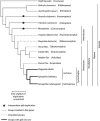Evolution and expression of BMP genes in flies
- PMID: 23595982
- PMCID: PMC3744649
- DOI: 10.1007/s00427-013-0445-9
Evolution and expression of BMP genes in flies
Abstract
Bone morphogenetic proteins (BMPs) play key roles in development. In Drosophila melanogaster, there are three BMP-encoding genes: decapentaplegic (dpp), glass bottom boat (gbb) and screw (scw). dpp and gbb are found in all groups of insects. In contrast, the origin of scw via duplication of an ancestral gbb homologue is more recent, with new evidence placing it within the Diptera. Recent studies show that scw appeared basal to the Schizophora, since scw orthologues exist in aschizan cyclorrhaphan flies. In order to further localise the origin of scw, we have utilised new genomic resources for the nematoceran moth midge Clogmia albipunctata (Psychodidae). We identified the BMP subclass members dpp and gbb from an early embryonic transcriptome and show that their expression patterns in the blastoderm differ considerably from those seen in cyclorrhaphan flies. Further searches of the genome of C. albipunctata were unable to identify a scw-like gbb duplicate, but confirm the presence of dpp and gbb. Our phylogenetic analysis shows these to be clear orthologues of dpp and gbb from other non-cyclorrhaphan insects, with C. albipunctata gbb branching ancestrally to the cyclorrhaphan gbb/scw split. Furthermore, our analysis suggests that scw is absent from all Nematocera, including the Bibionomorpha. We conclude that the gbb/scw duplication occurred between the separation of the lineage leading to Brachycera and the origin of cyclorrhaphan flies 200-150 Ma ago.
Figures



Similar articles
-
Rapid evolution of a novel signalling mechanism by concerted duplication and divergence of a BMP ligand and its extracellular modulators.Dev Genes Evol. 2010 Dec;220(9-10):235-50. doi: 10.1007/s00427-010-0341-5. Epub 2010 Nov 18. Dev Genes Evol. 2010. PMID: 21086136
-
Different requirements for proteolytic processing of bone morphogenetic protein 5/6/7/8 ligands in Drosophila melanogaster.J Biol Chem. 2012 Feb 17;287(8):5942-53. doi: 10.1074/jbc.M111.316745. Epub 2011 Dec 23. J Biol Chem. 2012. PMID: 22199351 Free PMC article.
-
Context-dependent relationships between the BMPs gbb and dpp during development of the Drosophila wing imaginal disk.Development. 2001 Oct;128(20):3913-25. doi: 10.1242/dev.128.20.3913. Development. 2001. PMID: 11641216
-
Position matters: variability in the spatial pattern of BMP modulators generates functional diversity.Genesis. 2011 Sep;49(9):698-718. doi: 10.1002/dvg.20778. Genesis. 2011. PMID: 21671348 Review.
-
Fish are like flies are like frogs: conservation of dorsal-ventral patterning mechanisms.Bioessays. 1997 Apr;19(4):281-4. doi: 10.1002/bies.950190404. Bioessays. 1997. PMID: 9136625 Review.
Cited by
-
SuperFly: a comparative database for quantified spatio-temporal gene expression patterns in early dipteran embryos.Nucleic Acids Res. 2015 Jan;43(Database issue):D751-5. doi: 10.1093/nar/gku1142. Epub 2014 Nov 17. Nucleic Acids Res. 2015. PMID: 25404137 Free PMC article.
-
The computational capabilities of many-to-many protein interaction networks.Cell Syst. 2023 Jun 21;14(6):430-446. doi: 10.1016/j.cels.2023.05.001. Cell Syst. 2023. PMID: 37348461 Free PMC article. Review.
-
Spatio-temporal patterns of ovarian development and VgR gene silencing reduced fecundity in parthenogenetic Artemia.Open Biol. 2023 Nov;13(11):230172. doi: 10.1098/rsob.230172. Epub 2023 Nov 15. Open Biol. 2023. PMID: 37963545 Free PMC article.
-
Components of the dorsal-ventral pathway also contribute to anterior-posterior patterning in honeybee embryos (Apis mellifera).Evodevo. 2014 Mar 12;5(1):11. doi: 10.1186/2041-9139-5-11. Evodevo. 2014. PMID: 24620747 Free PMC article.
-
A staging scheme for the development of the moth midge Clogmia albipunctata.PLoS One. 2014 Jan 7;9(1):e84422. doi: 10.1371/journal.pone.0084422. eCollection 2014. PLoS One. 2014. PMID: 24409296 Free PMC article.
References
Publication types
MeSH terms
Substances
LinkOut - more resources
Full Text Sources
Other Literature Sources
Molecular Biology Databases

